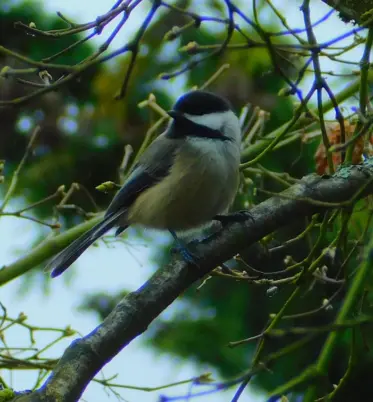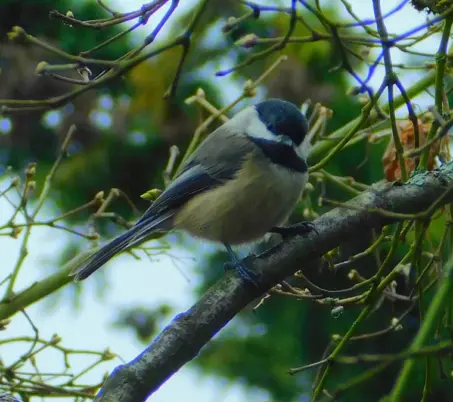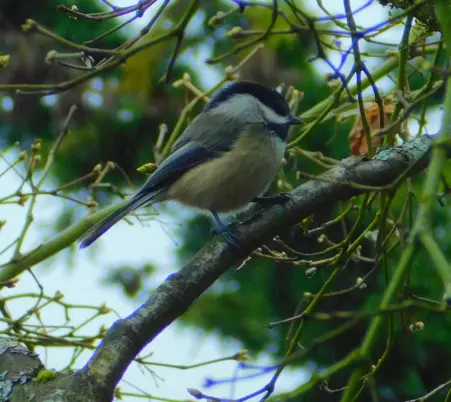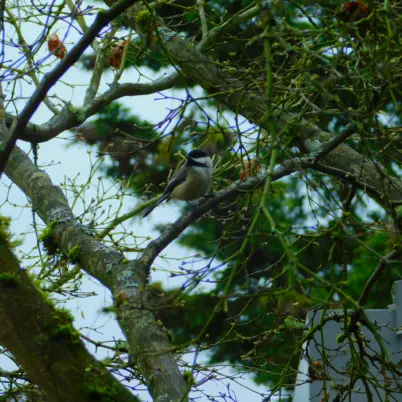Chickadee Brain Dump
by Marcia Wilson

Chickadees live year-round in Washington State, and one subspecies in particular thrives on campus. Masked like a bandit, the Black-capped is so charming and cute that most humans aren’t aware that other birds use it as their own “campus security”.
What’s in a Name? History
The Latin/Scientific name of the Black-capped Chickadee is the Poecile atricapillus. In English this means, Two-colored + Black-head. The striking black and white pattern of its head are the main identifying feature of this little charmer.
West-Coast bird lovers missed out on the drama of identifying the chickadees back East, as the bird was frequently confused for its cousin the titmouse. It was even called the “black-capped titmouse”. They are close cousins, and they flock together when they share the same range, but they are not the same bird. The titmouse’s original territory is expanding northwest, so this confusion with cousins may someday arrive in Washington.
“Titmouse” is a strange little combined word. “Tit” is an older English word that is probably related to the Norwegian tita, for “little bird” and the “mouse” was originally “mase” which is Old English for “tiny”–so, over time a compounded term devolved into the less-understandable name. In case readers are wondering, the plural for titmouse is titmouses, not titmice. Mice never had anything to do with the name other than a coincidental relationship with being small, lively, and gray.
English dialect has moved on, but the French-speaking Americans still call this little bird the Black-capped Titmouse, or, Mésange à tête noire. The Spanish name is Carbonero Cabecinegro, which also means Black-capped Titmouse.

Chickadee is based on onomatopoeia: the name is the sound it makes. Tracking backwards, the Tsalgi Nation’s name for it, the tsigili’i, became “chickadee” to the English language easily. Among the Yupik, the bird was similarly called cikepiipiiq.
Note: If the local Indigenous names for these birds can be provided, this article will update to include this pertinent information.
Alert, Alert!
Black-capped Chickadees are hyper-playful, curious, and alert. They believe in the Say it Loud approach to anything that alarms them. Its famous Chick-A-Dee-Dee call is actually a sharp way of screaming, LOOK OUT! LOOK OUT! The more the DEE-DEE-DEE is used, the greater the threat.
Other birds know this and are very quick to hang out with chickadees. Luckily for them, chickadees are fairly tolerant of other birds.
A Chilly Demeanor?
Chickadees are socially tolerant of other birds during the day…but not dependent. While many birds will gang up for warmth in cold weather, the chickadee would rather sleep by itself even on the chilliest days. They lower their own body temperatures at night, slipping into a form of controlled hypothermia that keeps them from burning off their precious fat stores too soon.
“Uksullaq, the Alutiiq word for the black-capped chickadee, means “winter one” — a nod to their year-round presence and cold hardy abilities.”—Leibich, Katrina.“Tshcick-a-dee-dee” Chickadees Sounds and Songs from the Northern Forests.
Hunting, and Hunting Some More.

Chickadees have a striking pattern of dark feathers around their eyes. This is like the eyeblack used by athletes in brightly lit conditions, and, helps them see a bit better by reducing glare. Some scientists suspect it also gives them an edge to survival, as a predator may not be sure if the prey is aware of them or not because it is just a little bit harder to tell if the chickadee is watching them. Again, other birds seem to be aware that in a dangerous world, a chickadee is a good egg to hang with! Off-campus, they are frequently seen in the college marshlands, where comfortable dead snags and willows provide good places to hide, nest, and seek food. In warmer months they feed heavily on any catchable insects, but in the cold months they happily embrace seeds, nuts, berries, and any form of fat. They have no qualms about bellying up to a buffet at the feeder, but they won’t stick around. They’ll grab their food and take off, hiding what they can’t eat for future meals.
Chickadee Brain Dump

Chickadees may not have a very large brain, but what they have, they use. They sing bilingually after socializing with different chickadee species. Every fall, their brains kill off some neurons, and rebuild them to adapt to the new season’s changed paradigm of food, predator, and environment. The hippocampus gets 30% larger in the winter to store memory on where the food supplies are cached. This seasonal swelling is made possible by the hippocampus being situated on top of its head–room to grow! Scientists shake their own heads a lot when it comes to the black-capped chickadee–in puzzlement as much as admiration.